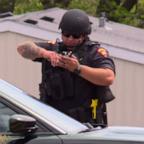Ground View: Journalists Struggle To Get The Lowdown in Danger Zone
Islamabad, Pakistan, Jan. 16, 2006 — -- Western journalists reporting on the war on terror from Pakistan have an unenviable task.
No one really wants us to get the full picture.
American and Pakistani spy efforts are shrouded in cloak and dagger: they don't wish their enemy to know exactly what they're ever up to. Al Qaeda also needs to veil its activities to survive.
First off, journalists have little access to the area we report on. Travel to Pakistan's restive tribal belt is largely prohibited to the foreign press.
Often, the work we do here is like putting together a puzzle when you don't know what the final picture looks like. We get a few bits of information interviewing the local villagers who witnessed something. Local intelligence officials offer a shred of information. We try to glean some insight from flight logs at Bagram Airbase.
Sometimes, months pass before we get the detail that gives us real insight. Often, we never know for sure.
So who was killed last Friday in the American air strike on a village in the tribal belt?
Our local team that traveled there got good information, still, I wonder if we'll ever really know.
No one is quite sure of the location of five bodies -- men apparently attending a high-level Al Qaeda meeting.
Even if the corpses are located, will DNA tests prove anything?
Was Osama bin Laden's right-hand man and spiritual adviser Ayman al Zawahiri there?
Was Mullah Omar, the reclusive leader of the Taliban of Afghanistan, present?
Maybe it was just a group of cousins and some informant to the CIA had a grudge against them.
It would not be the first time that has happened.
What is significant in this case and what we know for sure is that more than one dozen villagers, many of them women and children, died.
America's image in Pakistan got trashed again too.
One hundred days ago today, when a massive and devastating earthquake struck Kashmir and northern Pakistan, U.S. soldiers, the United States Agency for International Development (USAID) and American aid workers rushed to the rescue.
Their work helped tens of thousands of people here, and in doing so, changed the generally low view many Pakistanis held of the American people.
"I see those helicopters flying over my house every day and I am really touched," a Pakistani friend told me. "It is an amazing thing your country has done here."
But with one air strike -- and 13 villagers dead -- all that goodwill is gone again. There have been anti-U.S. protests in cities across the country. U.S. citizens living here have been warned by the embassy to keep a low profile.
Pakistan may have a large extremist population, but it is important Americans understand that as reporter here you find that the majority of people in this country are moderate and want peace with America and Europe.
Quietly, they agree with government efforts to rid the tribal belt of terrorists -- but not like this.
I hope, as we in the media try and muddle through the shreds of information available to us, that we can prove there was a point to the recent strike. I hope it does not turn out that three homes reduced to rubble and 13 lives snuffed out were no more than collateral damage.
I hope, I guess, that the U.S. government's information, in this case, was better than ours.




